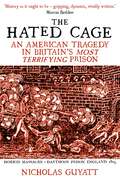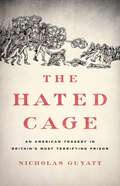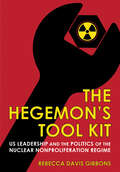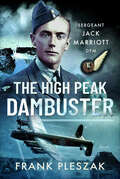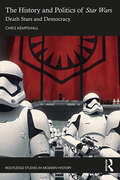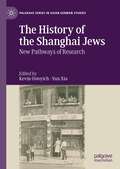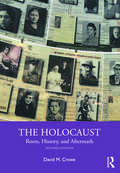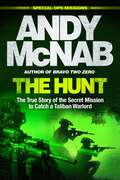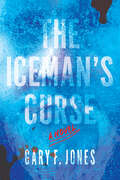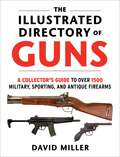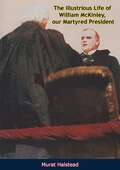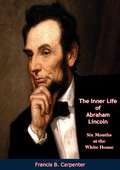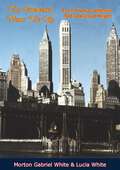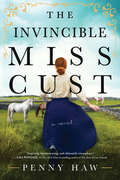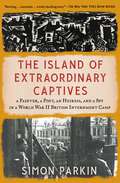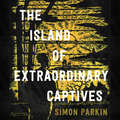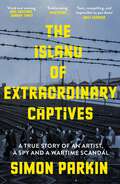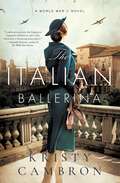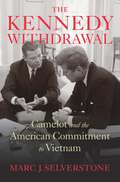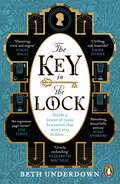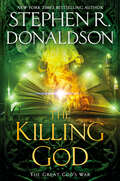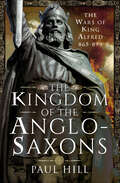- Table View
- List View
The Hated Cage: An American Tragedy in Britain's Most Terrifying Prison
by Nicholas Guyatt&‘Beguiling&’ The Times &‘This is history as it ought to be – gripping, dynamic, vividly written&’ Marcus Rediker The War of 1812 – the last time Britain and America went to war with each other. British redcoats torch the White House and six thousand American sailors languish in the world&’s largest prisoner-of-war camp, Dartmoor. A myriad of races and backgrounds, with some prisoners as young as thirteen. Known as the &‘hated cage&’, Dartmoor wasn&’t a place you&’d expect to be full of life and invention. Yet prisoners taught each other foreign languages and science, put on plays and staged boxing matches. In daring efforts to escape they lived every prison-break cliché – how to hide the tunnel entrances, what to do with the earth… Drawing on meticulous research, The Hated Cage documents the extraordinary communities these men built within the prison – and the terrible massacre that destroyed these worlds.
The Hated Cage: An American Tragedy in Britain's Most Terrifying Prison
by Nicholas GuyattA leading historian reveals the never-before-told story of a doomed British prison and the massacre of its American prisoners of warAfter the War of 1812, more than five thousand American sailors were marooned in Dartmoor Prison on a barren English plain; the conflict was over but they had been left to rot by their government. Although they shared a common nationality, the men were divided by race: nearly a thousand were Black, and at the behest of the white prisoners, Dartmoor became the first racially segregated prison in US history.The Hated Cage documents the extraordinary but separate communities these men built within the prison—and the terrible massacre of nine Americans by prison guards that destroyed these worlds. As white people in the United States debated whether they could live alongside African Americans in freedom, could Dartmoor&’s Black and white Americans band together in captivity? Drawing on extensive new material, The Hated Cage is a gripping account of this forgotten history.
The Hegemon's Tool Kit: US Leadership and the Politics of the Nuclear Nonproliferation Regime (Cornell Studies in Security Affairs)
by Rebecca Davis GibbonsAt a moment when the nuclear nonproliferation regime is under duress, Rebecca Davis Gibbons provides a trenchant analysis of the international system that has, for more than fifty years, controlled the spread of these catastrophic weapons. The Hegemon's Tool Kit details how that regime works and how, disastrously, it might falter. In the early nuclear age, experts anticipated that all technologically-capable states would build these powerful devices. That did not happen. Widespread development of nuclear arms did not occur, in large part, because a global nuclear nonproliferation regime was created. By the late-1960s, the United States and the Soviet Union had drafted the Treaty on the Non-Proliferation of Nuclear Weapons (NPT), and across decades the regime has expanded, with more agreements and more nations participating. As a result, in 2022, only nine states possess nuclear weapons. Why do most states in the international system adhere to the nuclear nonproliferation regime? The answer lies, Gibbons asserts, in decades of painstaking efforts undertaken by the US government. As the most powerful state during the nuclear age, the United States had many tools with which to persuade other states to join or otherwise support nonproliferation agreements. The waning of US global influence, Gibbons shows in The Hegemon's Tool Kit, is a key threat to the nonproliferation regime. So, too, is the deepening global divide over progress on nuclear disarmament. To date, the Chinese government is not taking significant steps to support the nuclear nonproliferation regime, and as a result, the regime may face a harmful leadership gap.
The High Peak Dambuster: Sergeant Jack Marriott DFM
by Frank PleszakOperation Chastise, the audacious attack on the dams in the Ruhr valley, is arguably one of the most famous airborne attacks in history. During the night of 16/17 May 1943, 133 men in nineteen specially-adapted Lancasters – the famous Dambusters – set off to attack six dams deep in the heart of Germany. Eight of the bombers, and 56 of the aircrew, did not come home. Three of the aircrew who took part were from the High Peak region of Derbyshire. Flight Lieutenant Bill Astell, the pilot of ED864 who hailed from Coombs near Chapel-en-le-Frith, was killed after flying into electricity pylons on the way to the dams. The navigator in ED924, Sergeant John Nugent, from Stoney Middleton, survived the Dambusters Raid but was killed later in the war. The third High Peak Dambuster, on whom this biography concentrates, is the little-known Sergeant Jack Marriott from Chinley, the flight engineer on Lancaster ED937 during the attack. Marriott’s Lancaster, Z-Zebra, reached the Möhne Dam, only to discover that it had been breached, some five bouncing bombs already having been released at it. The crew, led by Squadron Leader Henry Maudslay DFC, then flew on to the Eder Dam where their ‘bouncing bomb’ exploded beneath the Lancaster after hitting the parapet of the structure. The damaged Lancaster struggled homeward, but was shot down on the Dutch border; Jack, together with his crew, was killed in the crash. In this autobiography, Frank Pleszak explores Jack’s life, his RAF service prior to joining 617 Squadron, and then the events leading up to and during Operation Chastise itself. But for Jack, one the immortal Dambusters, his story continued on after that historic night – particularly during the filming of the 1955 epic Dam Busters in which his aircraft features.
The History and Politics of Star Wars: Death Stars and Democracy (Routledge Studies in Modern History)
by Chris KempshallThis book provides the first detailed and comprehensive examination of all the materials making up the Star Wars franchise relating to the portrayal and representation of real-world history and politics. Drawing on a variety of sources, including films, published interviews with directors and actors, novels, comics, and computer games, this volume explores the ways in which historical and contemporary events have been repurposed within Star Wars. It focuses on key themes such as fascism and the Galactic Empire, the failures of democracy, the portrayal of warfare, the morality of the Jedi, and the representations of sex, gender, and race. Through these themes, this study highlights the impacts of the fall of the Soviet Union, the War on Terror, and the failures of the United Nations upon the ‘galaxy far, far away’. By analysing and understanding these events and their portrayal within Star Wars, it shows how the most popular media franchise in existence aims to speak about wider contemporary events and issues. The History and Politics of Star Wars is useful for upper-level undergraduates, postgraduates, and scholars of a variety of disciplines such as transmedia studies, science fiction, cultural studies, and world history and politics in the twentieth and twenty-first centuries.
The History of the Shanghai Jews: New Pathways of Research (Palgrave Series in Asian German Studies)
by Kevin Ostoyich Yun XiaThis volume provides a historical narrative, historiographical reviews, and scholarly analyses by leading scholars throughout the world on the hitherto understudied topic of Shanghai Jewish refugees. Few among the general public know that during the Second World War, approximately 16,000 to 20,000 Jews fled the Nazis, found unexpected refuge in Shanghai, and established a vibrant community there. Though most of them left Shanghai soon after the conclusion of the war in 1945, years of sojourning among the Chinese and surviving under the Japanese occupation generated unique memories about the Second World War, lasting goodwill between the Chinese and Jews, and contested interpretations of this complex past. The volume makes two major contributions to the studies of Shanghai Jewish refugees. First, it reviews the present state of the historiography on this subject and critically assesses the ways in which the history is being researched and commemorated in China. Second, it compiles scholarship produced by renowned scholars, who aim to rescue the history from isolated perspectives and look into the interaction between Jews, Chinese, and Japanese.
The Holocaust: Roots, History, and Aftermath
by David M. CroweNow in its second edition, this book takes a fresh, probing look at one of the greatest human tragedies in modern history. Beginning with a detailed overview of the history of the Jews and their two-millennia-old struggle with the anti-Judaic and anti-Semitic prejudice and discrimination that set the stage for the Holocaust, David M. Crowe discusses the evolution of Nazi racial policies, beginning with the development of Adolf Hitler's anti-Semitic ideas, their importance to the Nazi movement in the 1920s and 1930s, and their expanding role in the evolution of German policies leading to the Final Solution in 1941 – the mass murder of Jews throughout Nazi-occupied Europe. The German program involved the creation of death camps like Auschwitz and Treblinka and mass murder sites throughout Eastern Europe and the Soviet Union. While the Jews were the principal victims, other groups who were deemed racial or biological threats to Hitler’s goal of creating an Aryan-pure Europe were also targeted, including the Roma and the handicapped. This book discusses Nazi policies in each country in German-occupied Europe as well as the role of Europe’s neutrals in the larger German scheme-of-things. It also takes an in-depth look at liberation, Displaced Persons, the founding of Israel, and efforts throughout the western world to bring Nazi war criminals and their collaborators to justice. This second edition includes a new chapter on the importance of memory and the Holocaust, the evolution of interpretative Holocaust scholarship and media, recent controversies about national responsibility, and the work of Holocaust museums, archives, and libraries in Israel, Germany, Poland, and the United States to promote Holocaust education and memory. It concludes with the rise of Neo-Nazism, white nationalism, and other movements in Germany and the United States, and their relationship to questions about Holocaust memory and its lessons. Comprehensive and offering a detailed historical perspective, this is the perfect resource for those looking to gain a deep understanding of this tragedy.
The Hunt: The True Story of the Secret Mission to Catch a Taliban Warlord
by Andy McNabFrom master storyteller Andy McNab, this is the opening book in an adventure-filled and action-packed new series telling, for the first time ever, the true stories of Special Forces missions. 'McNab's first major non-autobiographical work of non-fiction ... The operation is told like a novel [...] and it is as refreshingly informal and compellingly immediate as his other books' Daily Express'Part history lesson, part military manual, part fixed-bayonets thriller. A must for Special Forces fans' The SunIt is the early 2000s and 9/11 is fresh in the world's memory. The Taliban have taken over Afghanistan, and armed militants and explosive devices are terrorising the people. And now a new threat is emerging in the country: suicide bombings, ordered by military commander of the Taliban, Mullah Dadullah.Special Forces are sent in to stop him.The Hunt is the thrilling story of the secret mission to catch Dadullah, one of the most dangerous men alive. Using classified sources and his unique insight into the way the SAS works, Andy McNab gives a page-turning account of what it took the Special Forces to find their target and what they would have to do to take him down.An explosive story of hostage negotiations, undercovers missions and a final, epic assault on Dadullah's compound that could leave only one side alive, The Hunt is a powerful retelling of a real-life Special Forces mission.
The Hunt: The True Story of the Secret Mission to Catch a Taliban Warlord
by Andy McNabFrom master storyteller Andy McNab, this is the opening book in an adventure-filled and action-packed new series telling, for the first time ever, the true stories of Special Forces missions. 'McNab's first major non-autobiographical work of non-fiction ... The operation is told like a novel [...] and it is as refreshingly informal and compellingly immediate as his other books' Daily Express'Part history lesson, part military manual, part fixed-bayonets thriller. A must for Special Forces fans' The SunIt is the early 2000s and 9/11 is fresh in the world's memory. The Taliban have taken over Afghanistan, and armed militants and explosive devices are terrorising the people. And now a new threat is emerging in the country: suicide bombings, ordered by military commander of the Taliban, Mullah Dadullah.Special Forces are sent in to stop him.The Hunt is the thrilling story of the secret mission to catch Dadullah, one of the most dangerous men alive. Using classified sources and his unique insight into the way the SAS works, Andy McNab gives a page-turning account of what it took the Special Forces to find their target and what they would have to do to take him down.An explosive story of hostage negotiations, undercovers missions and a final, epic assault on Dadullah's compound that could leave only one side alive, The Hunt is a powerful retelling of a real-life Special Forces mission.
The Iceman's Curse
by Gary F. JonesNature, climate, and stupidity produce a pandemic.Grant Farnsworth, a post-doc student, veterinarian, and virologist at the University of Minnesota is upset when his professor tells him to prepare to work on tissue samples from a 1,200-year-old corpse called the Iceman, that was found in the Swiss Alps. Grant is already working seven days a week and his wife is eight months pregnant with their second child. The situation becomes more complicated when a Swiss professor, to avoid regulations, smuggles the samples into the United States, putting Grant and his professor in legal jeopardy.When a blizzard diverts the professor's flight to Chicago, Customs is hectic, and the professor mistakenly swaps his suitcase with Frank, a drug mule. When Frank discovers the mistake he and a friend follow the professor north on I-94 with the intention to do whatever is necessary to recover the missing drugs. When snow forces the professor to stop at a motel in the hamlet of Kirby, Wisconsin, he has no idea that he's carrying drugs and that his life is in jeopardy.When Switzerland announces that those who handled Iceman samples are ill, and several have died, Grant is sent to Kirby to find the Swiss professor and isolate the samples. At the same time, the CDC learns of the samples in Kirby and dispatches Dr. Sybil Erypet to Fort McCoy, a nearby Army base, to get the samples under control.Between dangerous drug mules and infected tissue samples, many lives in the snow-bound village are in jeopardy.
The Illustrated Directory of Guns: A Collector's Guide to Over 1500 Military, Sporting, and Antique Firearms
by David MillerWritten by a technical expert who has fired many of the guns featured, this book includes wide and varied assemblage of weapons from each of the world&’s major manufacturing countries.The Illustrated Directory series provide readers with a fully illustrated, comprehensive reference book packed with timelines, historical facts, and images designed to inform and excite. At 512 pages packed with information and photographs, this book is a necessary addition to any enthusiast's library. Complete with full specification table with each entry including type, origin, caliber, and size, The Illustrated Directory of Guns is the most ambitious and lavishly illustrated history of guns for the collector and enthusiast. It shows in clear, detailed photographs and text over 1500 guns with separate sections on Pistols, Revolvers, Rifles, Shotguns (military and sporting), Machine Guns, and Submachine guns. A few featured include:RemingtonSmith & WessonWinchesterGlockVickersMauserBrowningColtBerettaAnd more Organized A-Z by country and gunmaker's name, the book clearly shows the different types of gun which the world has used to hunt, wage war, break and defend its laws, hone its sharpshooting skills, and fire purely for the fun of it. The book also features an introduction on each section, which gives a brief history of the development of that particular kind of firearm.
The Illustrious Life of William McKinley, our Martyred President
by Murat HalsteadThe true story of the assassination, the shadow of death, passing away, funeral ceremonies together with his ancestry, boyhood, student days, his career as soldier, lawyer, statesman, governor, and president, the principles for which he stood and the triumphs he achieved, and his home life.
The Inner Life of Abraham Lincoln: Six Months at the White House
by Francis B. Carpenter“Late in 1863 a young painter named Francis B. Carpenter wished to commemorate the issuance of the Emancipation Proclamation. The likable and well-connected Carpenter received President Lincoln’s consent during a visit to the White House. “Well, Mr. Carpenter, we will turn you loose in here,” said Lincoln. The painter set up a studio in the state dining room and worked for months in 1864 under a lighted chandelier. It was a marvelous opportunity to observe the president and converse with him.The Inner Life of Abraham Lincoln is Carpenter’s account of his experience. He watched the daily parade of petitioners who came to Lincoln’s office—worried mothers, desperate job-seekers, needy widows and orphans. He heard Lincoln’s own account of the decision to abolish slavery by proclamation, heard him recite Shakespeare, and heard him say often, “That reminds me of a story. . . .” He dealt with little Tad, gathered anecdotes from insiders, excerpted published reminiscences from former associates like William H. Herndon. He added his own impressions of the president, noting a deep melancholy underneath the famous humor.This book, originally published in 1866, struck a chord with a public hungering for intimate details about the fallen president. Carpenter’s painting, The First Reading of the Emancipation Proclamation before the Cabinet, was finished earlier, displayed in the rotunda of the Capitol before Lincoln’s second inauguration, and then exhibited on a northern tour. Reproductions hung in many homes, offices, and schoolrooms.”-Print ed.
The Intellectual Versus The City: From Thomas Jefferson To Frank Lloyd Wright
by Morton Gabriel White Lucia WhiteAS CITIZENS OF A HISTORICALLY FRONTIER LAND, AMERICANS HAVE AN INHERENT DISTRUST OF THE CONFINEMENTS AND COMPLEXITIES OF THE CITY.But this ingrained romanticism about the natural life—the authors insist—does not fully explain American anti-urbanism. They point out that not only men like Emerson and Melville, but cosmopolitan figures such as Henry James, John Dewey and Theodore Dreiser have considered the American city a sinister place. The great architect Frank Lloyd Wright wanted to demolish the metropolis and replace it with a revolutionary form of living. Even the world-famous industrialist Henry Ford has said, “We shall solve the City Problem by leaving the City.”Tracing back across a century and a half, exploring the fields of art, philosophy, and sociology, Morton and Lucia White reveal what important Americans have said about their cities, and why. The authors suggest that modern city planners and social scientists have something to learn from these great dissenters, from their troubling wisdom and their urgent prophecies.From Thomas Jefferson to Frank Lloyd Wright our nation’s most distinguished artists, leaders, and intellectuals have proclaimed open hostility toward the city. Unlike the Englishman’s London or the Frenchman’s Paris, they have found nothing to love in the sprawling American metropolis. This significant and thoughtful study analyzes for the first time the major intellectual reactions to urbanism that have appeared through a century and a half of American history and offers some provocative conclusions as to why our cities have been the traditional object of prejudice, fear, and distrust.“A revealing analysis of American attitudes toward urbanization and urban life.”—New York Times“Excellent”—Harper’s“This lucid and imaginative book opens up new vistas in our understanding of our past and of our present.”—Arthur Schlesinger, Jr.
The Invincible Miss Cust: A Novel
by Penny HawSheReads Best Historical Fiction of 2022 Finalist!"Inspiring, heartwarming, and ultimately triumphant." —Lisa Wingate, #1 New York Times bestselling author of The Book of Lost Friends"What a remarkable woman—and what an enthralling story!" —Janet Skeslien Charles, New York Times bestselling author of The Paris LibraryMust-read historical fiction for fans of Marie Benedict and Tracey Enerson Wood, based on the real life of Britain's first woman veterinary surgeon.Aleen Cust has big dreams. And no one—not her family, society, or the law—will stop her.Born in Ireland in 1868 to an aristocratic English family, Aleen knows she is destined to work with animals, even if her family is appalled by the idea of a woman pursuing a veterinary career. Going against their wishes but with the encouragement of the guardian assigned to her upon her father's death, Aleen attends the New Veterinary College in Edinburgh, enrolling as A. I. Custance to spare her family the humiliation they fear. At last, she is on her way to becoming a veterinary surgeon! Little does she know her biggest obstacles lie ahead.The Invincible Miss Cust is based on the real life of Aleen Isabel Cust, who defied her family and society to become Britain and Ireland's first woman veterinary surgeon. Through Penny Haw's meticulous research, riveting storytelling, and elegant prose, Aleen's story of ambition, determination, family, friendship, and passion comes to life. It is a story that, even today, women will recognize, of battling patriarchy and an unequal society to realize one's dreams and pave the way for other women in the face of seemingly insurmountable odds.More Praise for The Invincible Miss Cust:"The Invincible Miss Cust is an absolute delight, an exceptional, immersive work of historical fiction set amid the beautifully detailed landscapes of Ireland and England." —Jennifer Chiaverini, New York Times bestselling author of Switchboard Soldiers"A skillfully told story of an extraordinary woman's grit, determination, and devotion to her dream. Detailed and evocative, The Invincible Miss Cust is an engrossing read." —Shana Abé, New York Times bestselling author of The Second Mrs. Astor"I loved this gripping and inspirational book! Her courage and independence of spirit shine through on every beautifully-written page as she faces life's triumphs and tragedies." —Fiona Valpy, bestselling author of The Dressmaker's Gift"An amazing story! Haw's descriptive prose and deft characterizations lead us through Cust's remarkable life, setbacks and triumphs, and leaves us in awe of her perseverance, determination, and loyalty." —Katherine Reay, bestselling author of The London House and The Printed Letter Bookshop
The Island of Extraordinary Captives: A Painter, a Poet, an Heiress, and a Spy in a World War II British Internment Camp
by Simon ParkinThe &“riveting…truly shocking&” (The New York Times Book Review) story of a Jewish orphan who fled Nazi Germany for London, only to be arrested and sent to a British internment camp for suspected foreign agents on the Isle of Man, alongside a renowned group of refugee musicians, intellectuals, artists, and—possibly—genuine spies.Following the events of Kristallnacht in 1938, Peter Fleischmann evaded the Gestapo&’s roundups in Berlin by way of a perilous journey to England on a Kindertransport rescue, an effort sanctioned by the UK government to evacuate minors from Nazi-controlled areas.train. But he could not escape the British police, who came for him in the early hours and shipped him off to Hutchinson Camp on the Isle of Man, under suspicion of being a spy for the very regime he had fled. During Hitler&’s rise to power in the 1930s, tens of thousands of German and Austrian Jews like Peter escaped and found refuge in Britain. After war broke out and paranoia gripped the nation, Prime Minister Winston Churchill ordered that these innocent asylum seekers—so-called &“enemy aliens&”—be interned. When Peter arrived at Hutchinson Camp, he found one of history&’s most astounding prison populations: renowned professors, composers, journalists, and artists. Together, they created a thriving cultural community, complete with art exhibitions, lectures, musical performances, and poetry readings. The artists welcomed Peter as their pupil and forever changed the course of his life. Meanwhile, suspicions grew that a real spy was hiding among them—one connected to a vivacious heiress from Peter&’s past. Drawing from unpublished first-person accounts and newly declassified government documents, award-winning journalist Simon Parkin reveals an &“extraordinary yet previously untold true story&” (Daily Express) that serves as a &“testimony to human fortitude despite callous, hypocritical injustice&” (The New Yorker) and &“an example of how individuals can find joy and meaning in the absurd and mundane&” (The Spectator).
The Island of Extraordinary Captives: A True Story of an Artist, a Spy and a Wartime Scandal
by Simon ParkinA gripping untold war story: using exclusive new archive material, letters and diaries, this is the story of the prisoners of war in internment camps during the Second World War.The police came for Peter Fleischmann in the early hours. It reminded the teenager of the Gestapo's moonlit roundups he had narrowly avoided at home in Berlin. Now, having endured a perilous journey to reach England - hiding from the rampaging Nazi thugs at his orphanage, boarding a Kindertransport to safety - here the aspiring artist was, on a ship bound for the Isle of Man, suspected of being a Nazi spy. What had gone wrong?In May 1940, faced with a country gripped by paranoia, Prime Minister Winston Churchill ordered the internment of all German and Austrian citizens living in Britain. Most, like Peter, were refugees who had come to the country to escape Nazi oppression. They were now imprisoned by the very country in which they had staked their trust. Painstakingly researched from dozens of unpublished first-hand accounts and previously classified documents, The Island of Extraordinary Captives tells, for the first time, the story of history's most astonishing internment camp and of how a group of world-renown artists, musicians and academics came to be seen as 'enemy aliens'. The Island of Extraordinary Captives is the story of a battle between fear and compassion at a time of national crisis. It reveals how Britain's treatment of refugees during the Second World War led to one of the nation's most shameful missteps, and how hope and creativity can flourish in even the most challenging circumstances.(P) 2022 Hodder & Stoughton Limited
The Island of Extraordinary Captives: A True Story of an Artist, a Spy and a Wartime Scandal
by Simon Parkin*An OBSERVER, TABLET, NEW STATESMAN and GUARDIAN SATURDAY MAGAZINE "Books of 2022" pick *The police came for Peter Fleischmann in the early hours. It reminded the teenager of the Gestapo's moonlit roundups he had narrowly avoided at home in Berlin. Now, having endured a perilous journey to reach England - hiding from the rampaging Nazi thugs at his orphanage, boarding a Kindertransport to safety - here the aspiring artist was, on a ship bound for the Isle of Man, suspected of being a Nazi spy. What had gone wrong?In May 1940, faced with a country gripped by paranoia, Prime Minister Winston Churchill ordered the internment of all German and Austrian citizens living in Britain. Most, like Peter, were refugees who had come to the country to escape Nazi oppression. They were now imprisoned by the very country in which they had staked their trust. Painstakingly researched from dozens of unpublished first-hand accounts and previously classified documents, The Island of Extraordinary Captives tells, for the first time, the story of history's most astonishing internment camp and of how a group of world-renown artists, musicians and academics came to be seen as 'enemy aliens'. The Island of Extraordinary Captives is the story of a battle between fear and compassion at a time of national crisis. It reveals how Britain's treatment of refugees during the Second World War led to one of the nation's most shameful missteps, and how hope and creativity can flourish in even the most challenging circumstances.
The Italian Ballerina: A World War II Novel
by Kristy CambronAt the height of the Nazi occupation of Rome, an unlikely band of heroes comes together to save innocent lives in this breathtaking World War II novel based on real historical events.Rome, 1943. With the fall of Italy&’s Fascist government and the Nazi regime occupying the streets of Rome, British ballerina Julia Bradbury is stranded and forced to take refuge at a hospital on Tiber Island. But when she learns of a deadly sickness sweeping through the quarantine wards—a fake disease known only as Syndrome K—she is drawn into one of the greatest cons in history. Alongside hospital staff, friars of the adjoining church, and two Allied medics, Julia risks everything to rescue Jewish Italians from the deadly clutches of the Holocaust. Soon a little girl who dreams of becoming a ballerina arrives at their door, and Julia is determined to reunite the young dancer with her family—if only she would reveal one crucial secret: her name.Present Day. Delaney Coleman recently lost her grandfather—a beloved small-town doctor and World War II veteran, so she returns home to help her aging parents. When a mysterious Italian woman reaches out claiming to own one of the family&’s precious heirlooms, Delaney is compelled to travel to Italy and uncover the truth of her grandfather&’s hidden past. With the help of the woman&’s skeptical but charming grandson, Delaney learns of a Roman hospital that saved hundreds of Jewish people during the war. Soon, everything Delaney thought she knew about her grandfather comes into question.Based on true accounts of the invented Syndrome K sickness, The Italian Ballerina journeys from the Allied storming of the beaches at Salerno to the London ballet stage and the war-torn streets of World War II Rome, exploring the sometimes heart-wrenching choices we must make to find faith and forgiveness, and how saving a single life can impact countless others.Split timeline: WWII and present dayStand-alone novelBook length: approximately 107,000 wordsIncludes discussion questions for book clubs
The Italian Girl
by Anita AbrielA fearless young Italian woman risks everything to save precious artworks from the Nazis in a gripping new tale from the bestselling author of The Light After the War. Rome, 1943: Marina Tozzi adores her father Vittorio and working together in his art gallery is her only escape from the reality of the Nazi occupation. Not only has Marina inherited her father&’s passion for art but she is earning a reputation as an expert in her own right. However, Vittorio is keeping a deadly secret from his daughter. He has been hiding a Jewish artist in their basement and one day Marina returns home to find her father has been brutally murdered by a German officer. Devastated, Marina flees to Florence to seek help from a man who owes Vittorio his life. Renowned American art expert Bernard Berenson offers Marina sanctuary in his villa outside Florence and a job cataloguing his vast art library. Marina is grateful but she is determined to find a way to avenge her father. When handsome young artist Carlos proposes using her expertise to help the partisan cause against the Nazis, she has at last found her purpose. In one daring and ingenious act, Marina risks her life to save a priceless painting from falling into Nazi hands and proves her worth to the partisans. But falling in love with Carlos was not part of her plan. When Carlos suddenly disappears, Marina&’s dreams about building a life with him after the war turn to ashes. She will have to travel halfway around the world to unravel the past – and find her future.Praise for Anita Abriel &‘I was utterly moved and transfixed&’ Kristin Harmel &‘Fans of historical fiction won&’t want to miss this evocative, heartbreaking story&’ Beatriz Williams &‘Beautifully written and heartfelt&’ Jillian Cantor
The Kassandra Plan: The Vatican Spy who tried to stop the invasion of the USSR (N.A. #1)
by Atanasio FdHMarch 1941. The armies of the Third Reich spread throughout Europe ... This is the story of the first mission of Simon de Haro, the boy who became a Jesuit, the Jesuit who became an agent of the Holy Alliance, the Vatican Secret Service, and who tried to stop the cruelest war of the 20th century ... and it is also the story of Hannah Kozlova, a Jewish girl thrown into a terrifying Soviet orphanage in Leningrad. It is a story of struggle, of overcoming, of extreme suffering, of memories of a lost life that will intertwine with the present, and of moments of overflowing happiness.
The Kennedy Withdrawal: Camelot and the American Commitment to Vietnam
by Marc J. SelverstoneA major revision of our understanding of JFK’s commitment to Vietnam, revealing that his administration’s plan to withdraw was a political device, the effect of which was to manage public opinion while preserving US military assistance.In October 1963, the White House publicly proposed the removal of US troops from Vietnam, earning President Kennedy an enduring reputation as a skeptic on the war. In fact, Kennedy was ambivalent about withdrawal and was largely detached from its planning. Drawing on secret presidential tapes, Marc J. Selverstone reveals that the withdrawal statement gave Kennedy political cover, allowing him to sustain support for US military assistance. Its details were the handiwork of Defense Secretary Robert McNamara, whose ownership of the plan distanced it from the president.Selverstone’s use of the presidential tapes, alongside declassified documents, memoirs, and oral histories, lifts the veil on this legend of Camelot. Withdrawal planning was never just about Vietnam as it evolved over the course of fifteen months. For McNamara, it injected greater discipline into the US assistance program. For others, it was a form of leverage over South Vietnam. For the military, it was largely an unwelcome exercise. And for JFK, it allowed him to preserve the US commitment while ostensibly limiting it.The Kennedy Withdrawal offers an inside look at presidential decisionmaking in this liminal period of the Vietnam War and makes clear that portrayals of Kennedy as a dove are overdrawn. His proposed withdrawal was in fact a cagey strategy for keeping the United States involved in the fight—a strategy the country adopted decades later in Afghanistan.
The Key In The Lock: A haunting historical mystery steeped in explosive secrets and lost love
by Beth Underdown'Haunting, vivid and urgent' Stacey Halls'Absorbing, beautifully written' Rosie Andrews'An ingenious page turner' The Times--------------Inside lies a secret that won't stay hidden . . . The Great War is ending, but it has taken Ivy's son. Ivy is consumed by discovering what happened to her boy out there in the trenches, while her husband only wants to forget.Then a man comes back into Ivy's life who can help her find out. A man who once stole Ivy's heart. A man who also lost his son to a tragedy. A man whose name she hasn't spoken in thirty years.As Ivy questions her part in the fire at Polneath House, she unlocks a secret that's been burning ever since. But will the truth destroy her - or set her free?--------------'It will recruit fans of Du Maurier and Waters' Patrick Gale'A story of smouldering secrets, lingering guilt and hidden love' Daily Express'The perfect gothic novel' Stuart Turton'This is a novel of true elegance, deftly and satisfyingly plotted' Imogen Hermes Gowar'Atmospheric and rich with evocative detail' Harriet Tyce'An intriguing, elegantly constructed gothic mystery' Sunday Times'A smouldering gothic mystery that slowly envelopes you' Joseph Knox
The Killing God (The Great God's War #3)
by Stephen R. DonaldsonTwo kingdoms, ancient enemies, must stand alone against an implacable invader in the masterful conclusion of the Great God&’s War epic from the New York Times bestselling author of the Chronicles of Thomas Covenant.They are coming.The kingdoms of Belleger and Amika had been fighting for generations. But then they learned of a terrible threat moving through them to destroy the Last Repository, an immense hidden library. To face this greater enemy, King Bifalt of Belleger and Queen Estie of Amika allied their lands and prepared for war.They are at the door.Now the time of preparation is over. Black ships and sorcery test the cannon that defend the Bay of Lights. Treachery and betrayal threaten the kingdoms. The priests of the Great God Rile sow dissent. And Estie rides for the Last Repository, desperate to enlist the help of their Magisters—and to understand the nature of her own magical gift.They are here.Bifalt hates sorcery as much as he loves Estie, and the discovery that she could become a Magister shatters him. But he must rally and fight. Belleger and Amika are all that stand between the Great God&’s forces and his ultimate goal: the destruction of the Last Repository and its treasure of knowledge.
The Kingdom of the Anglo-Saxons: The Wars of King Alfred 865–899
by Paul HillIn this compelling military and political history of the Anglo-Saxon kingdom, Paul Hill explores England’s birth amidst the devastation and fury of the Danish invasions of the ninth century. He provides insight into the English response to the new challenges of warfare in these years of turbulence and danger. Alfred the Great, youngest son of King Æthelwulf, took control of the last surviving Anglo-Saxon kingdom, bringing Wessex and the ‘English’ parts of Mercia together into a new ‘Kingdom of the Anglo-Saxons’. This is a story of betrayal and of vengeance, of turncoat oath-breakers and loyal commanders, of battles fought and won against the odds. But above all, this is the story of how England came into being. Warfare in Alfred’s England changed from attritional set-piece battles to a grander strategic concern. This is explored, demonstrating how defense-in-depth fortification networks were built across the resurgent kingdom in the wake of Alfred’s victory at Edington in 878. The arrival of new Danish armies into England in the 890s would lead to campaigns quite unlike those of the Great Heathen Army of the previous generation. This is a human, as well as a military story: how a king demonstrated his right to rule was important. Alfred sought to secure the succession on his son Edward, who led his own forces as a young man in the 890s. But not everybody was happy in Alfred’s England. Despite the ever-present threat from the Danes, the greatest challenge facing Alfred arose from his own kin, centred deep in the heart of ancient Wessex. Alfred knew very well that his was not the only branch of the family who claimed a right to rule.
